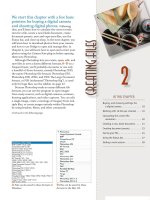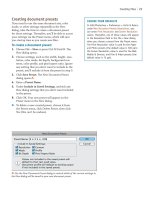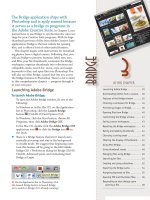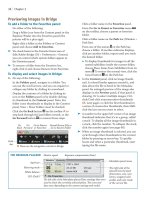Sử dụng photoshop cs5 part 5 docx
Bạn đang xem bản rút gọn của tài liệu. Xem và tải ngay bản đầy đủ của tài liệu tại đây (1.43 MB, 7 trang )
ptg
bridge
IN THIS CHAPTER
Launching Adobe Bridge . . . . . . . . . 29
Downloading photos from a camera . . 30
Features of the Bridge window . . . . . 32
Choosing a workspace for Bridge . . . . 34
Previewing images in Bridge . . . . . . . 36
Opening fi les from Bridge . . . . . . . . 40
Customizing the Bridge window . . . . 41
Saving custom workspaces . . . . . . . . 43
Resetting the Bridge workspaces . . . . 43
Rating and labeling thumbnails . . . . 44
Choosing a sorting order . . . . . . . . . 45
Filtering the display of thumbnails . . 45
Using Mini Bridge . . . . . . . . . . . . . . 46
Using thumbnail stacks . . . . . . . . . . 48
Managing fi les using Bridge . . . . . . . 49
Searching for fi les . . . . . . . . . . . . . 51
Creating and using collections . . . . . 52
Exporting the Bridge cache . . . . . . . 54
Assigning keywords to fi les . . . . . . . 55
Opening PDF and Illustrator fi les . . . . 56
Responding to alert dialogs upon
opening a fi le . . . . . . . . . . . . . . . 58
3
e Bridge application ships with
Photoshop and is aptly named because
it serves as a bridge to programs in
the Adobe Creative Suite.
In Chapter 1, you
learned how to use Bridge to synchronize the color set-
tings for your Creative Suite programs. With its large
thumbnail previews of les from Adobe Creative Suite
applications, Bridge is the best vehicle for opening
les, and it oers a host of other useful features.
i s c h a p t e r b e g i n s w i t h i n s t r u c t i o n s f o r d o w n l o a d -
ing photos from a digital camera. Following that, you
will use Bridge to preview, examine, label, rate, sort,
and lter your le thumbnails; customize the Bridge
workspace; organize thumbnails into collections and
collapsible stacks; search for, move, copy, and assign
keywords to les; and open les into Photoshop. You
will also use Mini Bridge, a panel that lets you access
the Bridge features in Photoshop. ere’s a lot to learn
in this comprehensive chapter — progress through it
at your own pace.
Launching Adobe Bridge
To launch Adobe Bridge:
To open the Adobe Bridge window, do one of the
following:
In Windows or in the Mac OS, on the Application
bar in Photoshop, click the Launch Bridge
button (Ctrl-Alt-O/Cmd-Option-O).
A
In Windows, click the Start button, choose All
Programs, then click Adobe Bridge CS5.
In the Mac OS, double-click the Adobe Bridge CS5
application icon or click the Bridge icon on
the Dock.
➤ ere is a Bridge feature that lets it launch auto-
matically at startup and stay in the background
in stealth mode. We suggest that beginning users
turn this feature o by going to the Edit/Adobe
Bridge CS5 > Preferences dialog for Bridge (Ctrl-K/
Cmd-K), Advanced panel, and unchecking Start
Bridge at Login.
A
On the Application bar in Photoshop, click
the Launch Bridge button to launch Bridge
(or to switch to Bridge if it’s already running).
ptg
30 Chapter 3
Downloading photos from a camera
When you use a digital camera, your photos are
stored on a removable memory card — most likely
a CompactFlash (CF) or Secure Digital (SD) card.
Rather than having to tether your camera directly to
a computer, you can remove the memory card and
insert it into a card reader device, then download
your photos from the card reader to your computer
via a USB cable or Firewire cable, depending on
which connection your camera supports (Firewire
is the faster of the two).
When you start downloading images from a
camera, your system’s default application or dialog
for acquiring images may launch automatically.
Instead of using the system dialog, we recommend
using the Photo Downloader application that is
included with Bridge. Instructions are provided here.
To download photos via a card reader and
Photo Downloader:
1. Take the card out of your camera and insert it
into the appropriate slot in the card reader.
2.
Plug the card reader into your computer. If the
default system application for acquiring photos
launches, exit/quit it.
3.
Launch Bridge, then click the Get Photos from
Camera button at the top of the Bridge
window.
e Photo Downloader dialog opens.
A
If an alert dialog appears and you want to make
Photo Downloader the default capture applica-
tion, click Yes (as we do); if not, click No.
4.
From the Get Photos From menu in the Source
area, select your card reader.
5.
In the Import Settings area, do the following:
To change the save location, click Browse/
Choose, then navigate to the desired folder.
Click OK/Choose again to assign that folder and
return to the Photo Downloader dialog.
To create a new subfolder within the folder
you just selected, choose a naming convention
from the Create Subfolder(s) menu, or choose
Custom Name and enter a folder name (or
choose None for no new subfolder).
Optional: To assign your digital images recogniz-
able names and shorter sequential numbers in
lieu of the long default number, choose a Custom
Name option from the Rename Files menu, then
enter a name and a starting number. A sample of
your entries displays in the Example eld.
A
i s i s t h e S t a n d a r d d i a l o g o f t h e P h o t o D o w n l o a d e r .
Check Open Adobe Bridge to have the photos
display in Bridge when the download is
completed.
Keep the Preserve Current Filename in XMP,
Convert to DNG, and Delete Original Files
options unchecked.
We recommend that you check Save Copies To
then click Browse/Choose to send copies of your
photos to a designated folder on an external hard
drive, as a backup.
ptg
Bridge 31
6. If you want to download select photos (instead
of the whole batch) from your memory card,
click Advanced Dialog to display the larger
Advanced dialog.
A
Below the thumbnail
window, click UnCheck All, then check the box
below each photo to be downloaded. Or click,
then Shift-click a sequence of photos, then
check the box for one of them; a check mark
will appear below each selected photo.
Optional: In the Apply Metadata area, enter
Creator and Copyright info to be added to
the metadata of all downloaded photos. is
data will display in Bridge.
➤ To switch back to the smaller Standard
dialog at any time, click Standard Dialog.
7.
Click Get Photos to start the downloading
process. When the downloading is nished,
the Photo Downloader dialog is dismissed
automatically. If you checked the Open Adobe
Bridge option, your photos will display in a new
window in Bridge. Don’t worry about preview-
ing or opening them just yet. We’ll step you
through that process later.
8.
Now that you’re done using the Photo
Downloader, you should insert a blank DVD
and burn the copies of your photo les to
the DVD as a permanent backup copy. In the
Mac OS, you can do this via drag-and-drop in
the Finder. If you need to learn how to copy
les to a DVD, consult the Help les for your
operating system.
A
i s A d v a n c e d d i a l o g o f t h e P h o t o D o w n l o a d e r c o n t a i n s t h e s a m e o p t i o n s a s t h e S t a n d a r d d i a l o g , p l u s m e t a d a t a f e a t u r e s
and an area for checking which photos are to be downloaded.
Check the box to
select a photo for
downloading
ptg
32 Chapter 3
Features of the Bridge window
First, we’ll identify the main sections of the Bridge
window, starting from the top (
A
, next page). e
two rows of buttons and menus running across
the top of the window are jointly referred to as the
toolbar. e second row of the toolbar is also called
the Path bar.
In the Essentials workspace, the main window is
divided into three panes: a large pane in the center
and a vertical pane on either side. Each pane con-
tains one or more panels, which are accessed via
tabs: Favorites, Folders, Filter, Collections, Export,
Content, Preview, Metadata, and Keywords. Panels
in the side panes let you manage les, lter the
display of thumbnails, and display le data; the
large central panel displays le thumbnails. At
the bottom of the Bridge window are controls
for changing the thumbnail size and format. (To
customize the Bridge workspace, see pages 34–35
and 41–43.)
We’ll explore the toolbar features and most of
the panels in depth in this chapter, but for the
moment, here is a brief description of the panels:
e Favorites panel displays a list of folders that
you’ve designated as favorites, for quick access. See
page 36.
e Folders panel contains a scrolling window with
a hierarchical listing of all the top-level and nested
folders on your hard drive. See page 36.
e Filter panel lists data specic to les in the
current folder, such as their label, star rating, le
type, date created, and date modied. By clicking
various listings in the Filter panel on or o, you
can quickly control which les from the current
folder display in the Content panel. To expand
or collapse a category, click the arrowhead. See
page 45.
e Collections panel displays the names (and
folder icons) of collections, which are user-created
groups of image thumbnails. Using the collection
features, you can organize and access your le
thumbnails without relocating the actual les. See
pages 52–53.
e Content panel displays image thumbnails (and
optional thumbnails for nested folders) within the
currently selected folder. In the lower right corner
of the Bridge window, you can click a View Content
button to control whether, and in what format,
metadata pertaining to the current les displays
in the Content panel (see page 42). For any view
type, you can change the thumbnail size via the
u m b n a i l s s l i d e r .
e Content panel is used and
illustrated throughout this chapter.
e Preview panel displays a large preview of the
image (or folder) thumbnail that you have selected
in the Content panel. If the thumbnail for a video
or PDF le is selected, a controller for playing the
video or for viewing the pages displays in this
panel. Two or more selected image thumbnails can
be previewed in this panel, for quick comparison,
and it has a loupe mechanism that you can use to
magnify the details of the previewed image. See
pages 36–38.
Detailed information about the currently selected
le displays in two locations in the Metadata
panel: a quick summary in the placard at the top
(see the sidebar on page 36) and detailed listings
within the categories below. e File Properties cat-
egory, for example, lists the le name, format, date
created, date modied, etc. To expand or collapse a
category, click the arrowhead. You can use the IPTC
Core category in the Metadata panel to attach cre-
ator, description, copyright, and other information
to the currently selected le (see the sidebar on
page 54). When the thumbnail for a digital photo is
selected, the Camera Data (EXIF) category displays
the camera settings that were used to capture the
photo. If the photo was edited in Camera Raw, the
panel will have a Camera Raw category in which
those settings will be listed.
Use the Keywords panel to assign one or more
descriptive subkeywords to your images, such as
an event, name, or location, so they can be located
more quickly (see page 55). You can run a search to
nd image thumbnails based on keyword criteria,
or display images by checking keywords in the
Filter panel (see page 45).
Note: e Export and Inspector panels aren’t
covered in this book.
ptg
Bridge 33
Display thumbnails
in Descending Order/
Ascending Order
Rotate
selected
thumbnails
Open
Recent
File
menu
Create
New
Folder
Delete
Item
Browse Quickly
by Preferring
Embedded Images
Sort
menu
Options for
u m b n a i l
Quality and
Preview
Generation menu
Filter Items
by Rating
menu
A
You’ll learn the function of the Bridge features throughout this chapter.
For navigation controls on
the toolbar, see page 36.
Workspace
menu
Get Photos
from Camera
Return to last
Adobe Creative
Suite application
★
Open in
Camera Raw
Output menu
(Web or PDF)
Rene menu
(Review Mode,
Batch Rename,
File Info)
Name of
currently
displayed
folder
u m b n a i l
Size slider
Path bar
Workspace
switcher
View
Content
as List
View
Content as
u m b n a i l s
View Content as Details
Lock umbnail
Grid
ptg
34 Chapter 3
Press the shortcut for one of the rst six
workspaces on the switcher (as listed on the
Workspace menu): Ctrl-F1/Cmd-F1 through
Ctrl-F6/Cmd-F6. e shortcuts are assigned
automatically to the rst six workspaces on the
switcher, according to their current order from
left to right.
➤ To change the order of workspaces on the
switcher, drag any name to the left or right.
➤ To learn how to resize the thumbnails in the
Content panel, see page 41.
Choosing a workspace for Bridge
To recongure the Bridge window quickly, choose
one of the predened workspaces. (To create and
save custom workspaces, see pages 41–43.)
To choose a workspace for Bridge:
Do one of the following:
On the upper toolbar, click Essentials,
Filmstrip, Metadata (List View for the thumb-
nails), Output, Keywords, Preview, Light
Table, Folders, or a custom workspace.
A
(To
display more workspace names, pull the gripper
bar to the left. )
From the Workspace menu on the workspace
switcher, choose a workspace
B–C
(and
A–C
,
next page).
C
e F i l m s t r i p w o r k s p a c e f e a t u r e s a l a r g e p r e v i e w o f t h e c u r r e n t l y s e l e c t e d t h u m b n a i l ( s ) .
A
Click a workspace name
on the workspace switcher…
B
…or choose a workspace name
from the Workspace menu
To reveal more workspace names,
drag the gripper bar to the left.
ptg
Bridge 35
A
In the Essentials workspace,
all the panels are showing.
C
In the Light Table work-
space, the Content panel
occupies the entire Bridge
window. Use this workspace
when you need to view a
large number of thumbnails.
B
In the Preview workspace,
the Metadata and Keywords
panels are hidden to make
room for a larger preview,
and the thumbnails display
in a vertical format (the
opposite arrangement from
the Filmstrip workspace).









